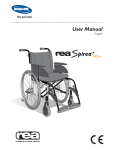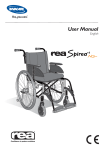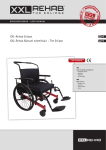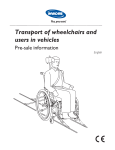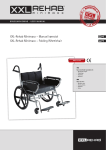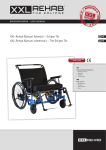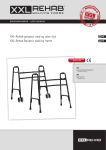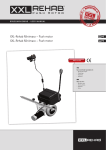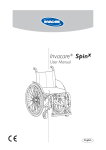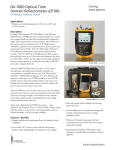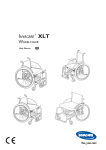Download User Manual - Invacare Rea
Transcript
User Manual English pirea 4 R ®Invacare Rea AB Every effort has been made to ensure that the contents of this publication are updated at the time of printing. As part of the ongoing improvement of our products, Invacare Rea AB reserves the right to modify existing models without prior notice. Any use of this publication, or parts thereof, as well as any reproduction of images, must have the written consent of Invacare Rea AB. 2 Contents 1. Generelt 4 1.1 Introduktion 4 1.2 Symboler 4 1.3 garanti 4 1.4 Fralæggelse af ansvar 4 1.5 Kundeservice 4 1.6 Copyright beskyttelse 4 1.7 Ulykker / Fare for ulykker 4 1.8 testning 4 1.9 TILSIGTET ANVENDELSE 4 rea Spirea4 NG 4 1.10 Levetid 4 Vi bedømmer at Invacare® kørestol har en levetid på 5 år. Det er svært at angive nøjagtig levetid for vore produkter. Den angivne tid er en anslået gennemsnitslevetid baseret på normal anvendelse. Denne livslængde kan være betydeligt længere, hvis kørestolen anvendes i begrænset omfang og varsomt, samt hvis den ved ligeholdes og passes på korrekt vis. Livslængden kan også være kortere, hvis kørestolen udsættes for ekstrem anvendelse 4 2. Sikkerhed 5 2.1 Løft af kørestolen 5 2.2 Dagligt tjek 5 2.3 Særlige ricisi 5 3. Tekniske data 6 3.1 Mål og vægt 6 3.2 Stof- og stelfarver 7 3.3 Tilbehør og optioner 7 3.4 sÆdehØjder 8 3.5 id label 10 Placering 10 4. Ved modtagelse af kørestolen 11 4.1 Kontrol ved modtagelse 11 4.2 Oversigt 11 Montering 12 Indstillinger 14 Vinkeljusterbare benstøtter 14 Faste benstøtter 14 FODPLADE OG LÆGSTØTTE 15 SÆDE 16 RYG 16 BREMSE 18 ARMLÆN 19 Drivhjul, indstillinger 20 INDSTILLINGER AF DRIVHJUL - HJÆLPERBETJENT BREMSE 22 Svinghjul, indstillinger 24 Tilbehør 25 ANTI-TIP 25 SKUBBEHÅNDTAG 26 AMPUTATIONSBENSTØTTE 27 Hovedstøtte 27 NAKKESTØTTE 28 ENARMSDRIFT 29 MONTERING AF HOFTEBÆLTE 30 Transport af kørestole med brugere i køretøjer 31 FASTSPÆNDINGSMETODER 33 Hvordan du forderede din kørestol til transport som bagage 34 Sikkerhedsanvisninger/køreteknik 35 Vedligeholdelse 37 3 1. General 1.1 INTRODUCTION This model has been designed to offer you all the features and functions you might need. After thorough inspections of the entire manufacturing process, we have only selected quality components for your wheelchair. This user manual describes what your wheelchair can do as well as the maintenance work and adjustments you and your carer can carry out. However, technical knowledge is required for making repairs (except for the inner tubes) and certain adjustments. This must therefore be done by your supplier. The Rea Spirea4 NG is designed for both indoor and outdoor use and to help people who are unable to walk long distances. Even though your Invacare wheelchair has been designed to work for a long time without problems, it is inevitable that wear and tear as well as daily use will eventually lead to the product becoming unusable. Invacare estimates that this product’s average lifetime is five years, provided that the product is maintained correctly according to the manufacturer’s recommendations. 1.2 SYMBOLS This symbol means warning and is used in the manual to point out information which is very important in order to avoid personal injury or damaging the product. 1.3 GUARANTEE We provide a two-year guarantee for the Rea Spirea4 NG from the delivery date. 1.4 GUARANTEE LIMITATIONS Invacare Rea AB accepts no responsibility for injuries or damage due to: • Failure to follow the user manual • Incorrect use • Wear damage to e.g. upholstery, tyres, tubes, hand rims and castor wheels is not covered by the guarantee. • Incorrect assembly or installation after the wheelchair has left the factory • Technical modifications • Unauthorised modifications and/or the use of generic spare parts • Damage caused by users weighing more than the specified user weight for each model is excluded Written consent from Invacare Rea AB must be granted before any work or adjustments, apart from those specified in the user manual, are made to the wheelchair. 4 1.5 COPYRIGHT ®Invacare Rea AB Every effort has been made to ensure that the contents of this publication are updated at the time of printing. As part of the ongoing improvement of our products, Invacare Rea AB reserves the right to modify existing models without prior notice. Any use of this publication, or parts thereof, as well as any reproduction of images, must have the written consent of Invacare Rea AB. 1.6 CUSTOMER SERVICES For contact details see the last page where you will find addresses for all European sales units. 1.7 ACCIDENTS/INCIDENTS Since this is a CE marked product, you are asked to immediately inform your Invacare office of any nearaccidents or accidents caused by this wheelchair and which could have led to or has led to personal injury. The relevant authority must also be notified. 1.8 TESTING The Rea Spirea4 NG has been tested and approved by TÜV in Germany and is CE marked in accordance with the Medical Devices Directive. 1.9 INTENDED USE REA SPIREA4 NG The Rea Spirea4 NG is a manual wheelchair for those who actively use their wheelchair for long periods of time (several hours in a row), for shorter periods of time or for transportation purposes. The Rea Spirea4 NG is intended for users who are able to propel the wheelchair by themselves but also for those who need someone to push the wheelchair. The Rea Spirea4 NG has features and accessories which allows the user to sit comfortably for several hours a day. Depending on the castor size (125-200 mm), the Rea Spirea4 NG can be used both indoors and outdoors. We recommend the larger castor wheels if you often use the chair on uneven surfaces. Note that the Rea Spirea4 NG can tip when used on a slope, especially if the slope is 8º or more. Use the anti-tip devices (and common sense)! The Rea Spirea4 NG is designed to be used in combination with a seat cushion placed on the seat. Without a seat cushion there is a risk of pressure sores. The Rea Spirea4 NG should always be equipped with leg rests if it is not propelled with the feet, and has a low seat height. 2. Safety 2.1 LIFTING THE WHEELCHAIR 2.3 SPECIFIC RISKS Listed below are several points which affect your own safety. Read this carefully. Invacare is only responsible for product changes carried out by authorised personnel. We reserve the right to make any changes to equipment and specifications without prior notice. Always lift the wheelchair at the points shown in the diagram. Never lift the wheelchair by the detachable arm rests or leg rests. Ensure that the back rest and push handles are secured in place. See also the chapter Safety instructions/Propelling techniques. By respecting the CE marking, combinations with other products with combination agreements with Invacare Rea are allowed. Contact Invacare Rea for a list of suppliers. Other adjustments carried out by the customer shall be deemed as a ”specially adjusted product” which means this must be documented and the customer takes over responsibility. Failure to comply with the instructions may result in personal injury and/or damage to the product. • • • Note that the wheelchair should not be lifted by the back rest bar. • • 2.2 DAILY PERFORMANCE CHECK • Check that the following parts have been correctly assembled on the wheelchair: • Wheels • Back rest • Anti-tip devices • Push handles • Foot rests • Brakes. • • • • • • Check the following before using the wheelchair: - that all parts are securely fastened to the frame - that all wheels and knobs are properly tightened - that all brakes and anti-tip devices function cor rectly - that the back rest and push handles are properly secured - that the wheelchair is stable and that there is no risk of tipping. Never lift the wheelchair by the detachable arm rests or foot rests. Always apply the brake before getting into or out of the chair. Never stand on the foot plates when getting into or out of the chair as there is a risk of the chair tipping over. The hand rims may become hot due to friction and this may cause injury to the hands. Changing the seat angle increases the risk of tipping. Use the anti-tip devices as much as possible. Remember that the brake is not as effective when the surface is wet, slippery or when on a slope. Make sure you check that the drive wheels are securely attached. Drive wheels are not be detached while the user is sitting in the chair. The more the Velcro straps on the back upholstery are slackened, the greater the risk of the wheelchair tipping. Frame parts or upholstery exposed to sunlight for long periods at a time can reach a temperature higher than 41°C. 5 3. Technical data 3.1 DIMENSIONS AND WEIGHT Seat width 35,5/38/40.5/43/45.5/ 48/50.5 cm Leg rest length Seat depth 40, 45, 50 (-5) cm Seat angle settings Seat height 38,5–51 cm Back angle settings Back rest height Arm rest height 35-55 cm 19–29 cm Total width Total height Seat width + 20 cm 32–53 cm Total depth 92-117 cm 6 0°– 6° -6° - +13° Collapsed width Weight Max. user weight 16 kg max 135 kg 30,5 cm 72-122 cm Crash test 3.2 UPHOLSTERY AND FRAME COLOURS Upholstery Black Jemima TR18 Frame colour Slate-grey 3.3 EQUIPMENT AND OPTIONS The Rea Spirea4 NG has a wide range of accessories and options. Back Back with adjustable angle Fixed back Fixed back upholstery Removable back upholstery with cover Seat Sling seat depth adjustable 5 cm Sling seat depth (5 cm) and tension adjustable. Seat cushion 5 cm Leg rests 80º leg rests Angle-adjustable leg rests Plaster leg rest Amputee leg rest Fixed foot plate Whole foot plate Angle and depth-adjustable foot plate Heel strap Calf strap Arm rests Side guards Height adjustable arm rests, long or short pad Hemiplegic arm rest Comfort arm rest, long or short pad Castor wheels 125-200 mm, pneumatic or solid, wide or narrow Drive wheels 16”, 22”, 24”, pneumatic, solid or puncture-proof Camber 0º or 2º Brake User brake Carer-operated brake One-arm brake Extended brake arm Others Several types of hand rim Spoke guards Anti tip devices Reflectors kit Table tray Pump Cane holder Tool kit External push handles, can be raised and lowered Safety belt Back rest bar Neck rest Head rest 7 3.4 SEAT HEIGHT TABLES 22'' DRIVE WHEEL, STANDARD DRIVE WHEEL ATTACHMENT SA 5 3 SH (cm) 4 SH (cm) SA SD40 SD45 SD50 SD40 38,5 41 3° 3° 3° 3° 3° 3° 3° 3° 3° 3° 3° 5 4 4 3 3 2 2 2 1 1 1 5 4 4 3 3 2 2 2 1 1 1 5 4 4 4 3 3 2 2 2 1 1 5 4 4 3 3 2 2 2 1 1 1 43,5 46 48,5 3 2 1 2 SD45 5 2 1 7 5 3 6 4 35 1 4 2 SD50 D mm 120 (5") 4 3 3 2 5 4 4 3 3 2 2 1 - 7 5 5 3 2 2 - 3 2 2 - 5 1 1 - 1 150 (6") 140 (5,5") 150 (6") 140 (5,5") 150 (6") 200 (8") 140 (5,5") 1 1 1 - 1 150 (6") 1 - 3 200 (8") 4 120 (5") 22'' DRIVE WHEEL, ACTIVE DRIVE WHEEL ATTACHMENT SA SH (cm) SH (cm) SA SD40 SD45 SD50 SD40 38,5 41 3° 3° 3° 3° 3° 3° 3° 3° 3° 3° 3° 5 4 4 3 3 2 2 2 1 1 1 5 4 4 4 3 3 2 2 2 1 1 5 5 4 4 3 3 2 2 2 1 1 5 4 4 3 3 2 2 2 1 1 1 43,5 46 48,5 8 7 5 3 2 1 SD45 5 6 4 35 1 SD50 4 2 D mm 120 (5") 4 3 3 2 5 4 4 3 3 2 2 1 - 7 5 5 3 2 2 - 3 2 2 - 5 1 1 - 1 150 (6") 140 (5,5") 150 (6") 140 (5,5") 150 (6") 200 (8") 140 (5,5") 1 1 1 - 1 150 (6") 1 - 3 200 (8") 4 120 (5") 24'' DRIVE WHEEL, STANDARD DRIVE WHEEL ATTACHMENT SA 5 3 4 3 2 1 2 SH (cm) SH (cm) SA SD40 SD45 SD50 SD40 41 43,5 3° 3° 3° 3° 3° 3° 3° 3° 3° 3° 5 4 4 3 3 3 2 2 2 1 5 4 4 3 3 3 2 2 2 1 5 5 4 4 3 3 3 2 2 1 5 4 4 3 3 3 2 2 2 1 46 48,5 51 SD45 5 7 5 3 6 4 35 1 D 4 2 SD50 mm 150 (6") 4 3 3 3 5 4 4 3 3 3 7 5 5 3 3 5 2 2 1 2 2 1 2 2 3 150 (6") 140 (5,5") 150 (6") 200 (8") 140 (5,5") 150 (6") 200 (8") 1 1 1 200 (8") 4 140 (5,5") 24'' DRIVE WHEEL, ACTIVE DRIVE WHEEL ATTACHMENT SA SH (cm) 7 5 3 SH (cm) SA SD40 SD45 SD50 SD40 41 43,5 3° 3° 3° 3° 3° 3° 3° 3° 3° 3° 5 4 4 3 3 3 2 2 2 1 5 5 4 4 3 3 3 2 2 1 5 5 4 4 3 3 3 2 2 1 5 4 4 3 3 3 2 2 2 1 46 48,5 51 SD45 5 6 4 35 1 SD50 4 2 D mm 150 (6") 4 3 3 3 5 4 4 3 3 3 7 5 5 3 3 5 2 2 1 2 2 1 2 2 3 150 (6") 140 (5,5") 150 (6") 200 (8") 140 (5,5") 150 (6") 200 (8") 1 1 1 200 (8") 4 140 (5,5") 9 16'' STANDARD DRIVE WHEEL ATTACHMENT 2 1 cm 46 2 2 2 1 50 INVACARE International SARL 10 7 5 3 6 4 35 1 3 3 5 1 4 2 D mm 140 (5,5") 150 (6") 200 (8") 200 (8") Date of manufacture 3.5 SERIAL NUMBER LABEL Model Serial number Max. user weight Positioning 1The serial number label is placed here. 13 12 2 11 3 10 4 9 5 8 4. Starting to use the wheelchair 6 7 4.1 DELIVERY CHECK Check that all parts comply with the delivery note. Any damage incurred during transport should be reported immediately to the delivery company. Retain all packaging until the transport company has inspected the consignment and an agreement has been reached. 4.2 WHEELCHAIR OVERVIEW 1. Backrest upholstery 2. Arm rest 3. Seat 4. Leg rest 5. Foot plate 6. Castor wheel 7. Castor housing 8. User brake 9. Hand rim 10. Drive wheel axle 11. Drive wheel attachment 12. Drive wheel 13. Backrest 11 ASSEMBLY 1. 1. Attach the drive wheels by pressing the button in the centre of the wheel while you slide the axle into the drive wheel plate. At this stage it is important that you check that the locking pin has actually locked the wheels into position. Take hold of the wheels and try to detach them. This should NOT be possible. 2. 2. Unfold the wheelchair by taking the seat’s edges and pressing these outwards/downwards. Be careful not to trap your fingers between the seat and frame tube. If you have a back rest bar, fold it up into position. 3. 3. Lower the detachable arm rests in their brackets on the frame. Do not put your fingers on the seat frame. 4a. 4a. Foot rests Attach the foot rests by pushing the pin at the upper part of the foot rest down into the wheelchair’s frame tube. The foot rests must be angled outwards when they are inserted. Lock the foot rests by turning them inwards. The foot rests are automatically locked so that there is no risk of them coming off the wheelchair. Be careful not to trap your fingers between the frame and foot rest. 12 4b. 4b. Leg rests, angle adjustable Attach the leg rests by pushing the pin at the upper part of the leg rest down into the wheelchair’s frame tube. The leg rests must be angled outwards when they are inserted. Lock the leg rests by turning them inwards. The leg rests are automatically locked so that there is no risk of them coming off the wheelchair. Be careful not to trap your fingers between the frame and leg rest. 13 SETTINGS ANGLE-ADJUSTABLE LEG RESTS Angle-adjustable leg rests support the legs and reduce pressure. The leg rests can be used for bandaged legs but not for legs in plaster casts. The leg rests must always be fitted with calf pads, foot rests and heel straps. 1. It is important to adjust the height and angle to get the best seating position possible. A Tool: 5 mm Allen key 1. Adjusting the leg rest height Adjust the leg rest’s height by loosening screw (A) with an Allen key. Adjust the leg support to a suitable height and the screw catches in one of the recesses on the leg rest tube. Then retighten the screw. 2. B 2. Leg rest angle Pull lever (B) with one hand while supporting the leg rest with your other hand. When a suitable angle is obtained, let go of the lever and the leg rest will lock into one of seven preset positions (C). Do not put any heavy objects or let children sit on the leg rest. It can damage the mechanism. C The distance between the lowest part of the foot plate and the ground must be at least 40 mm. FIXED LEG RESTS Adjusting the foot rest height Adjust the foot rest’s height by loosening screw (A) with an Allen key. As you adjust you will hear ”clicks”. One ”click” is equivalent to one height level. Adjust the foot support to a suitable height and the screw catches in one of the recesses on the leg rest tube. Then retighten the screw. C A 14 NB! Do not touch the upper screw (C). The distance between the lowest part of the foot plate and the ground must be at least 40 mm. FOOT PLATES/CALF PADS 1. Angle-adjustable foot rests Adjust the angle and depth of the foot rest by loosening the screw (A) with a 5 mm Allen key. You can then easily adjust the foot plate to the correct position. 1. Do not place anything on the foot plate when the screw is loose. A Tool: 5 mm Allen key C D 2. B 2. Calf pads The calf pads can be fitted in two different depth positions. Swing the pad forwards. Loosen the screw (B) with an Allen key. Move the large nut (C) from the reverse side and place it in the other attachment hole. Move the calf pad to the new position and secure it in place with the screw. The height of the calf pads can easily be adjusted using the hand wheel (D). Tool: 5 mm Allen key 3. A 3. Foot rest one-piece Adjust the angle and depth by loosening the two screws (A) by the foot rest fastener with a 5 mm Allen key. Adjust the foot rest to the correct position and tighten the screws. Do not put anything on the foot rest when the screws are loose. Tool: 5 mm Allen key The foot rest can be folded up. Lift the left side of the foot rest upwards. Be careful not to trap your fingers between the foot rest and the support when you fold it down. 15 SEAT 1. Adjusting the seat depth Fold the chair slightly by lifting the seat upwards. The front part of the seat is attached with Velcro straps from the back part of the seat. Pull up the Velcro strap and adjust by pulling the side of the seat forwards or backwards in the rails on the side tubes. Check that the adjustment is even on both sides. 1. When you have finished, fold the chair right out again and then attach the Velcro strap in the back part of the seat. 2. 2. Adjusting the shape Pull back the seat’s upper section so that the adjustable Velcro straps are visible. Use these straps to adjust the seat. Always have a cushion on the seat when testing if the shape is correct. The depth of this seat can also be adjusted in the same way as the fixed seat. BACK REST Adjusting the back rest height 1. Cut off both plastic ties (A) at the bottom of the back upholstery with a pair of scissors. Then fold the chair slightly by lifting the seat upwards. Or loosen and fold the back upholstery forwards 1. A 2 B Tool: 5 mm Allen key 16 2. Loosen the screws (B) on the reverse side of the back tubes with an Allen key. Now it is possible to raise and lower the back. Tighten the screws again. When the adjustment is complete, secure with new plastic ties on the back of the back upholstery if you have a fixed back upholstery. Tighten them properly! 3. Adjustable back The shape of the back can be adjusted with Velcro straps. The user must sit in the chair when the back is being adjusted. The shape can be adjusted to satisfy the existing support and comfort needs by using the Velcro straps. The straps in the lumbar region can for example be tightened to provide good support in the curve of the back and allow a more upright sitting position. When all adjustments are complete, fold the back upholstery back into place and secure it with the Velcro straps. 3. BACK ANGLE A Loosen the screw (A) on the inside and the screw (B) on the outside of the back tube. Angle to the desired position by turning the eccentric washer (C) (between 6º forward or 13º backward) with your hand or an Allen key. Tighten the screws again. Repeat this procedure on the opposite side. B C 17 BRAKES User brake A To engage the brake, move the lever (A) forwards. To release the brake, move the lever backwards (towards you). Be careful not to trap your fingers between the brake shaft and tyre. Adjusting the brake 1. First check that the tyres are inflated to the correct air pressure (you will find this on the tyre wall). Then loosen the screws (B) with an Allen key, slide the brake to the desired position and tighten. The correct distance between the brake shaft (C) and the tyre must be approx. 5 mm. Incorrect adjustments or use of the brake can reduce the braking effect. C B Tool: 5 mm Allen key Carer-operated brake 1. Applying the brake while moving: pull both brake handles upwards and the chair will come to a stop. 1. 2. 2. To lock the brakes: pull the brake handle and move the lock catch (A) downwards. Then let go of the handle. A 3. 3. To release the brakes: pull the brake handle and the lock catch will release automatically. Incorrect adjustments or use of the brake can reduce the braking effect. 18 ARM RESTS 1. Adjusting the arm rest height 1. Detachable arm rests If your wheelchair is equipped with arm rests that can be raised or lowered, you easily adjust the height by pulling up the arm rest and loosening the screw (A) under the arm rest. Move the screw up or down to the desired position and retighten the screw. Lower the arm rest again. A Tool: 5 mm Allen key Be careful not to trap your fingers between the side support plate and the frame when you adjust the height. 2. B 2. Adjust the height of the arm rests by turning the knob or loosening the screw (B), setting the desired height and then re-tightening the knob or the screw. Be careful not to trap your fingers between the arm rest pad and the side support plate when you adjust the arm rest height. Tool: 5 mm Allen key 19 DRIVE WHEEL SETTINGS A DRIVE WHEEL ATTACHMENTS Adjustable attachment for drive wheels. B With the attachment you can set five height positions and three lengthwise positions. A: B: C: D: C Standard - standard design Passive - set backwards for better stability Active Position for double amputees for increased stability and in order to prevent the amputee from tipping backwards, the drive wheel axels can be moved back from the back rest’s axel tube (special manual brakes are included in the package). D Adjustments to the wheels’ position and/ or fork angle must be carried out under the supervision of an expert who has made a complete risk assessment of the effect this change will have on the wheelchair’s function. Ask your adviser. The tip risk increases if the rear wheels are located in front of the backrest. Use anti-tip devices. E Changing the position of the drive wheel attachment The attachment can be moved up and down and be turned to obtain different seat heights. Loosen screws and nuts (E). Change the position of the drive wheel attachment. Tighten screws and nuts. When the wheels have been mounted in the correct position, it is important to check that screws and nuts have been tightened properly. Changing the position of the wheel on the attachment To change the position of the drive wheel on the attachment, first remove the wheel by pressing the quick release (F) on the axle and pull. Loosen the nut (G) and move the axle housing (H) to the new position. Tighten screws and nuts. F H G When you have fitted the wheels in the correct position, it is important that you check thoroughly that the nuts and screws are tightened securely. The axle housing should be tightened with a manual and dynamometric wrench calibrated to 40Nm. This is important for your own safety! Always remember to adjust the brakes, when the rearwheel position has been changed. 20 Changing camber The parts (A) of the drive wheel attachments that are fastened to the frame are shaped assymetrical (B) with a wider and a narrower upper and lower part. This gives the opportunity to camber the drive wheels 0° or 2° depending on how the drive wheel attachments are fastened to the frame. B A When the drive wheel attachments are mounted (forwards or backwards, see previous page) it is the outer, lower part (C) of the attachments that decides the camber of the rearwheels. The picture illustrates drive wheel attachments that give 0° camber. If the wider part of the attachment had been placed downwards the camber would have been 2° instead. C C 2° 0° 21 DRIVE WHEEL SETTINGS - CARER-OPERATED BRAKE 1. 1. Remove the drive wheel by pressing the button (A) on the wheel hub and pulling the drive wheel right out. Loosen the nut (B). Remove the brake unit from the drive wheel attachment. A B Tool: 22 mm fixed spanner 2. C D Tool: 5 mm Allen key 2. See the illustration (2) for the how the brake unit should be placed on the different drive wheel brackets. Note that the brake unit has two different points of attachment, one upper (C) and one lower (D). 22 3. 3. Place the brake unit in its new position. Make sure that the wire attachment (F) points upwards. Tighten properly. F 23 CASTOR WHEEL ADJUSTMENTS 1. 1. When you have found the seat height and seat angle you are happy with, it is important for the chair’s propelling ability to check that the angle between the castor attachment and the ground is 90°. 2. 2. Adjusting the angle Loosen the screws (A) approx. two turns. Adjust the castor housing to the correct angle by turning it. On the inside of the castor housing there are grooves that make it possible to adjust to 0°, 3° or 6° angles. When the castor housing is parallel to the tube, the angle is 0°. Do not forget to tighten the screws when you have reached the desired angle. A Check that the castor housing is fastened properly after the adjustment. Tool: 5 mm Allen key 3. A 3. Adjusting the height Loosen the lower of the two screws (A) completely. Loosen the upper screw approx. two turns. Move the castor housing upwards. Re-tighten the lower screw, although not completely. Adjust the angle according to step 2 above. Tighten both screws. Check that the castor housing is fastened properly after the adjustment. 0 24 Accessories ANTI-TIP DEVICE 1. Anti-tip device, rotatable The anti-tip device is foldable and both its height and depth can be adjusted. Please pay particular attention to how the anti-tip device is positioned when it is used. There will be a warning sticker if the anti-tip device has not been activated. A 1. Assembly Insert the two screws (A) into the holes of the castor wheel attachment and fit them into the holes of the anti-tip device. The height of the antitip device is adjusted according to the holes that are used. Screw tightly. Tool: 5 mm Allen key 2. 2. Adjusting the height To adjust the height, press on the two buttons (B) on each side of the housing and pull the tube (C) to the desired position (hole). The buttons will lock the tube in the correct place. B Do not use the buttons (B) to fold up the anti-tip device. C 3. Adjusting the depth The depth is adjusted by pressing the button (D) and pulling the tube to the desired depth. The button will lock the tube in the correct place. D 4. E The distance between the anti-tip device and the ground as well as the distance between the anti-tip device and the drive wheel should be 5 cm. 4. Swing mechanism To turn the anti-tip device under the wheelchair, press down the ”hub” (E) and pull it to one side. NB! A red sticker warns of a tipping risk. To activate the anti-tip device turn it back into place again. It will automatically lock into the right position. NB! _When the anti-tip device has been correctly activated the red sticker will be concealed. Use your foot to fold up the anti-tip device. If you use your hands there is a risk of getting them stuck between the device and the tube. Always use two anti-tip devices! Do not forget to fold out the anti-tip devices. The wheelchair can tip over! Check that the anti-tip devices are locked properly before use. 25 Anti tip device 1-2. The anti-tip device is also used as a step tube. It is easy to adjust the height. 1. Remove the plastic plugs from both the step tubes/ back frame parts. Push the anti-tip device into place and screw tightly with the nut (A) and screw (B). B 2. Pull the spring-loaded plastic washer back and slide the anti-tip device to the desired position. Make sure that the anti-tip device is secure in the new position. Always remember to fold down the anti-tip devices again when you have had then folded up. A Tool: _4 mm Allen key 10 mm socket spanner PUSH HANDLES Adjusting the push handles 1. 1. If your wheelchair has push handles that can be raised and lowered you can easily change the height by loosening the knob, setting it to the desired height and tightening the knob. 2. A 26 2. When the hole (A) is visible, at the top edge of the attachment, the handle will be in the correct ”lock position”. AMPUTEE LEG REST 1. A B 1. Attach the leg rests by pushing the pin at the upper part of the leg rests down into the tubes on the wheelchair. You must angle the leg rests outwards when you insert them. By twisting the leg rests this way they will lock and there will be no risk of them coming off the wheelchair. 2. Loosen the screw (A) on the cushion’s mounting to adjust the cushion’s angle and depth. Loosen the screws (B) to adjust the height. When using the amputee leg rest, the balance of the wheelchair changes. The risk is minimised by moving the drive wheels backwards in the drive wheel attachment and by using the passive or double amputee drive wheel attachments. See chapter on Drive wheel settings. Tool: 5 mm Allen key HEAD REST 1. 1. Use the hand knob (A) to adjust the height of and remove the head rest. The tube is equipped with a ”memory ring”. Loosen the screw (B), adjust, and tighten. B A Tool: 5 mm Allen key 2. Adjust the angle and depth with two screws (C) and the handle (D). Loosen and adjust. 2. C D Tool: 5 mm Allen key 27 3. 3. Adjust the sides by loosening the screw (E). Adjust and tighten the screw again. E Tool: 5 mm Allen key 4. To change the angle of the wings, loosen the screw (D). Adjust and tighten. 4. D Tool: 5 mm Allen key 1. NECK REST 1. Use the hand knob (A) to adjust the height of and remove the neck rest. The tube is equipped with a ”memory ring”. Loosen the screw (B), adjust, and tighten. B A Tool: 5 mm Allen key 2. C D Tool: 28 5 mm Allen key 2. Adjust the angle and depth with two screws (C) and the handle (D). Loosen and adjust. ONE ARM DRIVE A The one arm drive enables you to move the wheelchair with one hand. Two hand rims are installed on the same wheel. The drive wheel can be fitted on the right or left side. 1a. Remove the drive wheel Remove the drive wheel by pulling the button (A) and pulling the wheel off the wheelchair. 1b. Fitting the drive wheel When you put the wheel back, pull the button (A), upwards and secure the drive wheel to the hub. It is very important that you check that the lock catch has actually locked the wheel when you let go of the button. Test this by trying to pull the wheel off. This should NOT be possible. The hand rims can either be placed flush to each other (internal position) or with the inner, smaller, hand rim sticking out (external position). C 2. Changing the hand rim’s position. Loosen the three screws (B), take off the hand rim and turn it over. Put the hand rim back and screw the screws tight again. Be careful when you remove the telescopic drive shaft. Point it away from your body when you release the powerful steel spring found inside. NB! The drive shaft (C) is an important part of the wheelchair. Without this part the user would be unable to move the wheelchair. B D Be careful not to get your fingers trapped between the drive wheel’s spokes and the outer hand rim’s three brackets (D). Tool: 4 mm Allen key 10 mm socket spanner 29 PELVIC BELT The pelvic belt is used to avoid the risk of sliding out of the chair and to maintain a good posture. Check that the user is sitting right back in the wheelchair and that the back is as upright and symmetrical as possible - not slanted to one side or tipped backwards. Position the belt so that the hips can be seen above the belt. Adjust the length with the plastic buckles so that there is just room for one hand between the body and the belt. We recommend placing the lock in a central position, i.e. adjusting the length on both sides. These adjustments should be checked and possibly changed every time the belt is used. Fasten the belt on the frame with a screw and nut as in the illustration. A If the belt has come loose at the metallic clasp it should be threaded according to the pictures a-c. Make sure that the belt cannot slide. B C Thread the belt through the two plastic buckles as shown in the picture. It is important that both buckles are used. There is a danger the belt might slip if the belt is threaded through only one. 30 Transport of wheelchairs and users in vehicles Our wheelchairs are designed to offer the user as much comfort and safety as possible when using them in many different situations in their daily life. This means that compromises must be made for the product to be usable. When transporting by car it is always safest to sit in the car’s normal seats and use the car’s ordinary seatbelts which are only designed for car transport You should sit in the car’s normal seats and use the car’s seatbelt if possible. If for some reason it is completely impossible to travel in some other way, you may be transported in the wheelchair provided that the requirements and regulations below are followed. Although Invacare Rea’s products and regulations below are designed to increase safety when being transported in vehicles, passengers can still be injured if there is a crash or other near-accident. Invacare cannot make any guarantees as to what may happen in the event of incidents during transport in vehicles. The wheelchair has been tested and approved according to the 7176-19 standard using a normal setting and normal configuration. 1. 2. 3. 1. Wheelchairs with users must be transported facing forwards in the vehicle’s direction of travel. All additional equipment such as tables, body support, abduction pillows, etc. must be taken off before travelling and stored so that they will not cause any damage in the event of a near-accident. 2. The wheelchair must be secured in the vehicle with a four-point strap system. The user must wear a three-point safety belt fastened in the body of the car. Both must be approved according to ISO 10542-2. The wheelchair seat must be flat and the back must be as vertical as possible. 3. The points of attachment on the wheelchair where the tie straps must be secured are marked with this symbol. 31 4. 4. For a wheelchair to be used for transport in vehicles, it must be equipped with a pelvic belt. 5. 5. The car’s safety belt must be as tight as possible against the user’s body without being uncomfortable. The upper parts of the belt must lie against the user’s shoulder. No part of the belt must be twisted. 6. A 7. 6. The middle section of the car’s safety belt must be fixed around the user’s pelvis so that the angle of the pelvic belt is between 30° and 75° from the horizontal level. The higher the angle, the better, although never higher than 75°. 6. The safety belt should not be separated from the user’s body by parts of the wheelchair such as arm rests, wheels, etc. 8. 8. The neck rest must be attached to the wheelchair and set at a high level. 32 A Rea Spirea4NG A. Front restraints with straps 1. Connect the front straps around the front part of the chair’s frame. 2. Release the wheelchair’s brakes and tighten the front straps by pulling the chair backwards. 3. Brake the chair. B. Fastening at the back 1. Attach the snap hooks in the transport bracket by the back rest attachment. 2. Tighten the straps. C. Fastening the pelvic belt and safety belt 1. Check that the pelvic belt is securely fastened. 2. Fasten the car’s safety belt over the user. Note that the Rea Spirea4 NG should not be used for seated transport in a vehicle if the wheelchair is not equipped with transport brackets (A) and does not have a neckrest fitted 33 HOW TO DISASSEMBLE YOUR WHEELCHAIR AHEAD OF TRANSPORT AS LUGGAGE. When you want to transport the Rea Spirea4 NG, you can easily remove certain parts to make the chair smaller and lighter. 1. 1. Start by removing the arm rests. Press in the button on the spring to loosen the arm rest and then lift it straight up. 2a. 2a. Release the foot rests by moving the lever (B) forward or towards the sides while angling the rests outwards. You can then easily lift off the foot rests. B Be careful not to trap your fingers between the frame and the foot rest. 2b. C 2b. Loosen the leg rests by pressing in the lever (C) and turning the leg rests outwards. You can then easily lift off the leg rests. Be careful not to trap your fingers between the frame and the leg rest. 3. 3. Press the seat into a U shape. Take hold of both sides of the seat frame and fully collapse the wheelchair. If you have a back rest bar, remove it first by pressing in the catch on the inside of the left bracket and then folding the bar down. 4. 34 4. Remove the drive wheels by pressing the button in the centre of the wheel while pulling the wheel away from the wheelchair. Finally, fold the anti-tip devices upwards. Safety instructions/propelling techniques We recommend that you get your wheelchair tested by a qualified person who will make the adjustments you desire and also takes your build and needs into account. We also hope that you have received help with how best to use the chair. Start by carefully practising until you are familiar with the wheelchair’s possibilities and limitations. Moving to and from the wheelchair Propel the wheelchair as close as possible to the seat you want to move to. Apply the brakes. Remove/flip up the arm rests and detach the leg rests/move them outwards. Do not put any of your weight on the foot plates, as the chair may tip forwards. When moving from the wheelchair do not place your fingers between the frame tube and seat tube. Stretching and bending Position the wheelchair as close as possible. When you stretch and bend, your back must always be in full contact with the beck rest, otherwise the wheelchair may tip over. Stretching backwards over the back rest is not recommended. Propelling up a slope Many experienced users manage to propel up a slope by themselves. In order not to lose control of the steering and to avoid tipping backwards, you should always lean forward while propelling up a slope. Propel the wheelchair forwards using short and quick strokes to the hand rims in order to maintain speed and steering control. Generally help is needed when you come to steep slopes. If you have to stop on a slope, it is particularly important that you do not make any sudden or unexpected backward movement when you start moving the wheelchair forwards again. As the wheelchair is already leaning backwards, such a movement can cause the wheelchair to tip backwards. Be careful not to trap your fingers between the brake shaft and the tyre. Propelling down a slope We recommend that you have one or more assistants when going down steep and wet slopes. First check the slope to see if there are any particular risks, such as potholes, slippery sections, etc. Never use your block brake to slow down. When you apply the brake on a downward slope, the wheels lock and the wheelchair can suddenly pull to one side, tip sideways or stop immediately, throwing you out of the chair. Always control the speed with the hand rims. Remember that the hand rims may become hot due to friction and this may cause injury to the hands. Try to propel down the slope in a straight line as much as possible. Never 35 Onto a kerb This method assumes the assistant is always behind the wheelchair and creates the greatest safety for the user. The following advice is for the assistant: Illustration 1 Adjust the anti-tip devices upwards. Ensure that the user’s feet rest securely on the foot rests and cannot slide off before you lean the wheelchair backwards and push it forwards against the kerb. Illustration 2 Lower the front part of the wheelchair onto the pavement and stand as close to the wheelchair as possible before you lift up the whole wheelchair. Illustration 3 Lean forward and lift/roll the wheelchair over the kerb. Illustration 4 Lower the wheelchair onto the pavement so that the weight is divided across all four wheels. Ensure that the wheelchair does not roll backwards. Off a kerb Follow the procedure above but in reverse order (steps 4, 3, 2 and 1) to move off the kerb. Kerbs - Alternative method This method is generally used by experienced assistants who are stronger than average. The method can also be used when the kerb or step is low and only constitutes a minimal obstacle. The assistant steps backwards onto the pavement and pulls the wheelchair up onto the pavement. It is important for the assistant to use their body correctly to prevent injury. Tip the wheelchair backwards and roll the chair over the kerb onto the pavement. Take particular care if the kerb is wet or slippery. Escalators Do not use escalators with a wheelchair. Find out if there is a lift nearby. Stairs We advise you to avoid going up/down stairs in your wheelchair where possible and instead choose an alternative route. We recommend that you receive help from two assistants to get up and down stairs. One assistant goes in front and holds the wheelchair’s frame and the other goes behind and holds the push handles. Fold the anti-tip devices upwards. Balance the wheelchair on the drive wheels until the balance point is found. Then roll the chair step by step down the stairs by letting the wheelchair roll over the edge of each step. It is important that assistants remember not to hold detachable arm rests or leg rests. Assistants much also remember to lift correctly, using their legs and keeping their back as straight as possible. 36 Maintenance Care instructions Overview • Check the wheelchair once a week. If you discover any damage, please contact Invacare immediately. You will find the address and telephone number on the back cover of this manual. Cleaning • Wipe metal sections and the upholstery regularly with a damp cloth. A mild detergent (soap) can also be used. If necessary the upholstery can be washed at 40°C. An ordinary washing detergent can be used. Cleaning and disinfection 1. Remove all loose and detachable covers and wash these in a washing machine, following the washing instructions for each item. 2. Spray the wheelchair with detergent, e.g. car cleaning agent with wax, and let it set. 3. Rinse the wheelchair with a high-pressure spray or ordinary water spray depending on how dirty the chair is. Do not spray on bearings and draining holes. If you wash the wheelchair in a washing machine the temperature must not exceed 60°C. 4. Spray the chair with alcohol to disinfect it. 5. Let the chair dry in a drying room. Remove parts where water has gathered, e.g. end parts, ferrules, etc. If the chair has been washed in a machine, we recommend that you also blow-dry it with compressed air. Wheels and tyres • Wheel axels are to be wiped clean and greased with a drop of oil. • Pneumatic tyres have valves similar to those on a car tyre, and the tyres can be pumped up using the same type of pump used for cars. The recommended air pressure for drive wheels is: Standard tyres 3.5 bar 50 psi Low profile tyres 6.5 bar 90 psi The recommended air pressure for castor wheels is: (200 mm) 8” 4.0 bar (150 mm) 6” 2.5 bar When inflating the tyres there is a risk of explosion if they are inflated too much. Technical service • Only original parts or those approved and fulfilling Invacare’s specifications may be used. • All technical service must be carried out by an authorised wheelchair technician or by Invacare’s service department. You will find the address and telephone number on the back cover of this manual. Service life We estimate that the Rea(tm) Spirea4 NG(r) has a service life of five years. It is difficult to state the exact length of the service life of our products. The length stated is an estimated average service life based on normal use. The service life may be considerably longer if the wheelchair is used to a limited extent, and if it is used with care, maintained and handled properly. The service life may also be shorter if the wheelchair is subjected to extreme use. Near-accidents Please inform your Invacare office immediately of any accidents or near-accidents caused by this wheelchair and which could have led to or has led to personal injury. The relevant authority in your country must also be notified. 37 Claims Phone customer services (see back cover) if you wish to make a claim and state the reason for the claim and order a replacement item. You will be given a claim number which the return delivery must be clearly marked with. When you receive the replacement, return the broken item marked with the claim number. Testing The Rea Spirea4 NG has been tested and approved by the Swedish Handicap Institute and is CE marked according to the Medical Device Directive. Recycling The Rea Spirea4NG can be divided into the following main components: • Chassis • Plastic parts • Upholstery • Wheels, tyres and tubes • Packaging Chassis The chassis is made from aluminium and is fully recyclable. Recycling aluminium requires only 2-5 % of the energy used to make new aluminium. Plastic parts The plastic parts in the chairs are made of plastic belonging to the ”Thermoplastic” family and are marked with recycling symbols (where possible because of the part’s size). The main material is polyamide. This can be recycled or burned in the appropriately approved facilities. Upholstery The upholstery is made from polyester fibres, PUR or PVC. The most efficient way to recycle these is to burn them in appropriately approved facilities. Wheels, tyres and tubes • Hand rims, rims, spokes and hubs are made of steel, stainless steel or aluminium and can be recycled according to the above. • Tyres and tubes are made of rubber and can be recycled according to the above. Packaging All Invacare Rea AB packaging material is developed to fit the products in an optimal way to reduce the unnecessary wastage of material. All boxes are recyclable. Contact your local recycling centre to get correct information how to handle the above mentioned materials. Surface treatment Lacquered surfaces are lacquered with polyester. Some steel parts are zinc-plated. Un-lacquered aluminium parts are anodised. Visible wooden parts are lacquered 38 39 Manufacturer: Invacare Rea AB Växjövägen 303 S-343 71 DIÖ SWEDEN Sales Companies: Danmark: Invacare A/S, Sdr. Ringvej 37, DK-2605 Brøndby Tel: (45) (0)36 90 00 00, Fax: (45) (0)36 90 00 01 [email protected] Deutschland: Invacare Aquatec GmbH, Alemannenstraße 10, D-88316 Isny Tel: (49) (0)75 62 7 00 0, Fax: (49) (0)75 62 7 00 66 [email protected] Ulrich Alber GmbH, Vor dem Weissen Stein 21, D-72461 Albstadt-Tailfingen Tel: (49) (0)7432 2006 0, Fax: (49) (0)7432 2006 299 [email protected] Nederland: Invacare BV, Celsiusstraat 46, NL-6716 BZ Ede Tel: (31) (0)318 695 757, Fax: (31) (0)318 695 758 [email protected] [email protected] Norge: Invacare AS, Grensesvingen 9, Postboks 6230, Etterstad, N-0603 Oslo Tel: (47) (0)22 57 95 00, Fax: (47) (0)22 57 95 01 [email protected] [email protected] Österreich: Invacare Austria GmbH, Herzog Odilostrasse 101, A-5310 Mondsee Tel: (43) 6232 5535 0, Fax: (43) 6232 5535 4 [email protected] European Distributor Organisation: Invacare, Kleiststraße 49, D-32457 Porta Westfalica Tel: (49) (0)57 31 754 540, Fax: (49) (0)57 31 754 541 [email protected] Portugal: Invacare Lda, Rua Estrada Velha, 949, P-4465-784 Leça do Balio Tel: (351) (0)225 1059 46/47, Fax: (351) (0)225 1057 39 [email protected] España: Invacare SA, c/Areny s/n, Polígon Industrial de Celrà, E-17460 Celrà (Girona) Tel: (34) (0)972 49 32 00, Fax: (34) (0)972 49 32 20 [email protected] Sverige & Suomi: Invacare AB, Fagerstagatan 9, S-163 91 Spånga Tel: (46) (0)8 761 70 90, Fax: (46) (0)8 761 81 08 [email protected] [email protected] France: Invacare Poirier SAS, Route de St Roch, F-37230 Fondettes Tel: (33) (0)2 47 62 64 66, Fax: (33) (0)2 47 42 12 24 [email protected] Switzerland: Invacare AG, Benkenstrasse 260, CH-4108 Witterswil Tel: (41) (0)61 487 70 80, Fax: (41) (0)61 487 70 81 [email protected] Ireland: Invacare Ireland Ltd, Unit 5 Seatown Business Campus, Seatown Road, Swords, County Dublin Ireland Tel: (353) 1 810 7084, Fax: (353) 1 810 7085 [email protected] United Kingdom: Invacare Limited, Pencoed Technology Park, Pencoed, Bridgend CF35 5HZ Switchboard Tel: (44) (0)1656 776200, Fax: (44) (0)1656 776201 Customer services Tel: (44) (0)1656 776222, Fax: (44) (0)1656 776220 [email protected] Italia: Invacare Mecc San s.r.l., Via dei Pini 62, I-36016 Thiene (VI) Tel: (39) 0445 38 00 59, Fax: (39) 0445 38 00 34 [email protected] Art. No. 1536533 2010-05-17 Belgium & Luxemburg: Invacare nv, Autobaan 22, B-8210 Loppem Tel: (32) (0)50 83 10 10, Fax: (32) (0)50 83 10 11 [email protected]








































